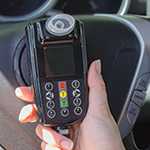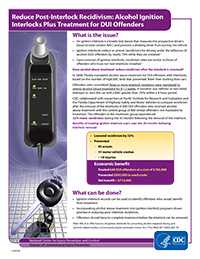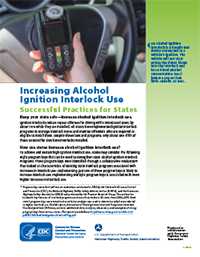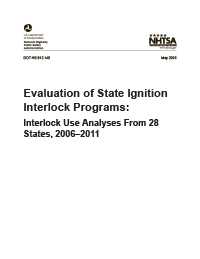Increasing Alcohol Ignition Interlock Use
Keep your state safe—increase alcohol ignition interlock use
Ignition interlocks reduce repeat offenses for driving while intoxicated (DWI) by about 70% while they are installed. All states have implemented ignition interlock programs to manage interlock issues and monitor offenders who are required or eligible to install them. Despite these laws and programs, only about one-fifth of those arrested for DWI have interlocks installed.
What is an alcohol ignition interlock?
 An alcohol ignition interlock is a breath-test device connected to a vehicle’s ignition. The vehicle will not start unless the driver blows into the interlock and has a blood alcohol concentration (BAC) below a pre-set low limit, usually .02 BAC.
An alcohol ignition interlock is a breath-test device connected to a vehicle’s ignition. The vehicle will not start unless the driver blows into the interlock and has a blood alcohol concentration (BAC) below a pre-set low limit, usually .02 BAC.
How can states increase alcohol ignition interlock use?
To achieve and sustain high ignition interlock use, states may consider the following eight program keys that can be used to strengthen state Alcohol Ignition Interlock Programs. These program keys were identified through a collaborative evaluation* that looked at characteristics of existing state interlock programs associated with increases in interlock use. Implementing just one of these program keys is likely to increase interlock use. Implementing multiple program keys is associated with even higher increases in interlock use.
Eight program keys for strong state alcohol ignition interlock programs
| Program Key | Characteristics of a Strong Program Key | Example |
|---|---|---|
| Require or incentivize use | Requirement or strong incentive to install interlocks | A law covering all offenders with significant reduction of hard license suspension period if interlock is installed |
| Levy strong penalties | Strong, swift, and appropriate penalties | Extension of interlock time, home monitoring, fail breath test, or tamper or otherwise circumvent interlock |
| Monitor interlocks to ensure proper use | Careful monitoring to assure interlocks are installed and used as intended | Random checks by DMV, probation, or treatment centers to ensure offender has installed and is using an interlock |
| Implement uniformly across state | Uniform and consistent implementation, statewide | All agencies report data regularly in compatible format, using uniform definitions of violations in same time frame |
| Coordinate across agencies | Close coordination and communication across all agencies | Regular communication with representatives from all interlock program involved agencies |
| Educate stakeholders about the program | Regular training or education for all interlock agency staff and management | Regular trainings between interlock program managers, law enforcement, vendors, DMV, and court staff |
| Provide adequate resources | Adequate staff and funding resources | Designated interlock program manager and staff, financial assistance for offenders |
| Use data for action | Excellent data records (including level of offense, BAC level at time of arrest, number of prior arrests, installation/ removal dates, violations) | Combined annual data on offenders available from all agencies to monitor offenders, report violators and evaluate program effectiveness |
Reports and Fact Sheets
- Page last reviewed: September 19, 2016
- Page last updated: September 19, 2016
- Content source:
- Centers for Disease Control and Prevention,
- National Center for Injury Prevention and Control,
- Division of Unintentional Injury Prevention


 ShareCompartir
ShareCompartir



